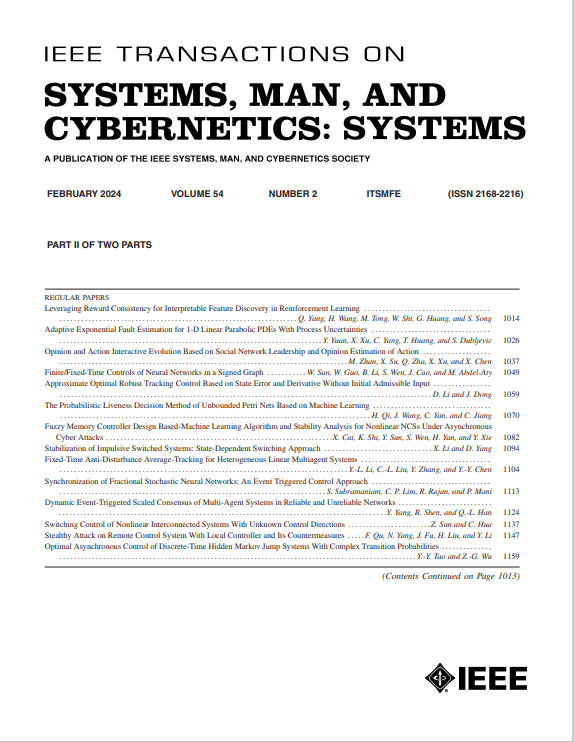Real-Time Data-Driven Hybrid Synchronization for Integrated Planning, Scheduling, and Execution Toward Industry 5.0 Human-Centric Manufacturing
IF 8.6
1区 计算机科学
Q1 AUTOMATION & CONTROL SYSTEMS
IEEE Transactions on Systems Man Cybernetics-Systems
Pub Date : 2025-06-06
DOI:10.1109/TSMC.2025.3572389
引用次数: 0
Abstract
Flexible and reconfigurable manufacturing systems with independent multiskilled cells are pivotal for mass customization under volatile demand, yet internal/external uncertainties persistently disrupt planning, scheduling, and execution (PSE), causing idle time and workflow instability. This study proposes a hybrid synchronization framework with hierarchical real-time data feedback to address heterogeneous demand-capacity synchronization (HDCS), reconciling demand volatility, system reconfigurability, and dynamic human capacity. The framework first adopts the ticket-enabled queuing mechanism of the graduation intelligent manufacturing system (GiMS) to enable seamless PSE integration, ensuring resilient operations. Next, it hybridizes a global optimization model with local adjustment mechanisms, utilizing multigranularity data to balance global optimality and local practicality under uncertainty. Finally, it implements a human-cyber-physical digitalization architecture to establish smart human-machine collaborative assembly. Validated through a case study, the method enhances cost-efficiency by 1.7%, punctuality by 29.5%, and resource utilization by 3.9% compared to conventional rescheduling strategies, demonstrating superior adaptability to uncertainties. The results validate its effectiveness in advancing human-centric smart manufacturing aligned with Industry 5.0 objectives, offering an integrated solution to HDCS challenges through synergistic coordination of hierarchical control, hybrid optimization, and human-machine collaboration.面向工业5.0以人为中心制造的集成计划、调度和执行的实时数据驱动混合同步
具有独立多技能单元的灵活可重构制造系统对于多变需求下的大规模定制至关重要,然而内部/外部的不确定性持续破坏计划、调度和执行(PSE),导致空闲时间和工作流程不稳定。本研究提出一种具有分层实时数据反馈的混合同步框架,以解决异构需求-容量同步(HDCS)问题,协调需求波动、系统可重构性和动态人力资源。该框架首先采用毕业智能制造系统(GiMS)的票证排队机制,实现PSE无缝集成,确保弹性运行。其次,将全局优化模型与局部调整机制相结合,利用多粒度数据平衡不确定性下的全局最优性和局部实用性;最后,实现了人-信息-物理数字化体系结构,建立了智能人机协同装配。通过案例研究验证,与传统的重新调度策略相比,该方法的成本效率提高了1.7%,准点率提高了29.5%,资源利用率提高了3.9%,显示出对不确定性的优越适应性。结果验证了其在推进与工业5.0目标一致的以人为中心的智能制造方面的有效性,通过分层控制、混合优化和人机协作的协同协调,为HDCS挑战提供了集成解决方案。
本文章由计算机程序翻译,如有差异,请以英文原文为准。
求助全文
约1分钟内获得全文
求助全文
来源期刊

IEEE Transactions on Systems Man Cybernetics-Systems
AUTOMATION & CONTROL SYSTEMS-COMPUTER SCIENCE, CYBERNETICS
CiteScore
18.50
自引率
11.50%
发文量
812
审稿时长
6 months
期刊介绍:
The IEEE Transactions on Systems, Man, and Cybernetics: Systems encompasses the fields of systems engineering, covering issue formulation, analysis, and modeling throughout the systems engineering lifecycle phases. It addresses decision-making, issue interpretation, systems management, processes, and various methods such as optimization, modeling, and simulation in the development and deployment of large systems.
 求助内容:
求助内容: 应助结果提醒方式:
应助结果提醒方式:


